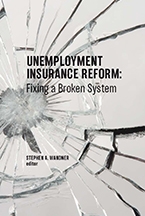
The Unemployment Insurance (UI) system is a lasting piece of the Social Security Act, which was enacted in 1935. But like most things that are over 80 years old, it occasionally needs maintenance to keep it operating smoothly while keeping up with the changing demands placed upon it. However, the UI system has been ignored by policymakers for decades and, say the authors in a new book from the Upjohn Press, it is now broken, out of date, and badly in need of repair.
In Unemployment Insurance Reform: Fixing a Broken System, editor Stephen A. Wandner pulls together a group of UI researchers, each with decades of experience, who describe the weaknesses in the current system and propose policy reforms that they say would modernize the system and prepare us for the next recession.
Wandner opens the book with a chapter titled “Why the Unemployment Insurance Program Needs to Be Reformed.” In it, he describes the UI program’s goals, history, and how policymakers have failed to adapt it to changing labor market and economic conditions. He also discusses the politics of UI reform and recent reform proposals.
Also included are:
“UI Reform Proposals in the Fiscal Year 2017 Obama Budget Request,” Suzanne Simonetta. Simonetta provides a useful overview of the workings of the federal-state UI system and how and why the system has evolved since its inception. She also discusses UI reforms proposed by the Obama administration in its budget request for Fiscal Year 2017, which were overlooked by Congress.
“The Employment Service–Unemployment Insurance Partnership: Origin, Evolution, and Revitalization,” David E. Balducchi and Christopher J. O’Leary. The Employment Service (ES), which helps UI recipients return to work, evolved over the years in partnership with UI. However, as Balducchi and O’Leary point out, the partnership began eroding during the 1980s and has continued to weaken. They describe how the partnership began and evolved, review evidence on the effectiveness of the services provided by ES, and suggest ways of revitalizing the partnership.
“State UI Financing Response to the Great Recession,” Wayne Vroman. Vroman notes that many states’ UI trust fund reserves were unprepared for the number of workers displaced during the Great Recession and therefore had to resort to borrowing to pay UI benefits. He also shows that many states are slow to restore those trust funds and so remain at risk of having to borrow when the next recession arrives. Vroman also analyzes states’ efforts to restore solvency to those funds, which may include raising UI taxes paid by employers and reducing UI recipients’ benefits.
“Unemployment Insurance Reform: Evidence-Based Policy Recommendations,” Christopher J. O’Leary and Stephen A. Wandner. O’Leary and Wandner focus on the need for UI reforms and compare two recent UI reform proposals to a proposal of their own, which calls for a balanced approach based on indexing both benefit payments and UI taxes.
“Conclusions and Needed Reforms,” Stephen A. Wandner. In the final chapter, Wandner lists several recommendations for comprehensive UI reform and explains how these reforms would impact regular and extended benefits, tax policy, and reemployment services.
Download the individual chapters above, or the entire book here.
The chapters in this book were first presented as papers at the 2016 Association for Public Policy and Management (APPAM) Fall Research Conference.
